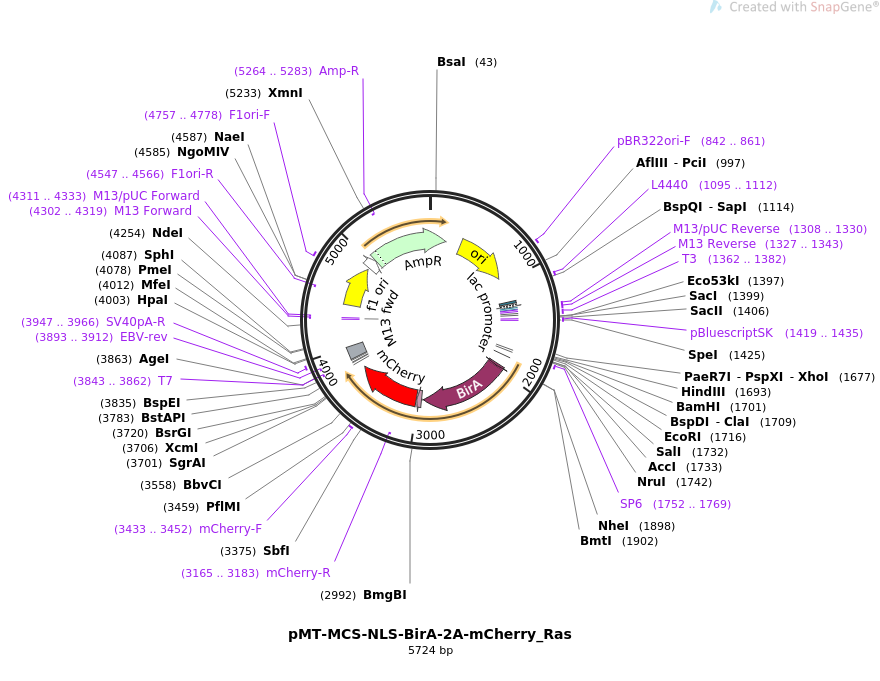

This view was shown to be incorrect by Dingwall and Laskey in 1982. In other words, there was thought to be no specific transport mechanism. The presence of several million pore complexes in the oocyte nuclear membrane and the fact that they appeared to admit many different molecules (insulin, bovine serum albumin, gold nanoparticles) led to the view that the pores are open channels and nuclear proteins freely enter the nucleus through the pore and must accumulate by binding to DNA or some other nuclear component.
#Nls mcherry snapgene series#
These experiments were part of a series that subsequently led to studies of nuclear reprogramming, directly relevant to stem cell research. The first direct experimental examination of the ability of nuclear proteins to accumulate in the nucleus was carried out by John Gurdon when he showed that purified nuclear proteins accumulate in the nucleus of frog ( Xenopus) oocytes after being micro-injected into the cytoplasm. Proteins required in the nucleus must be directed there by some mechanism. The nuclear membrane, therefore, separates the nuclear processes of DNA replication and RNA transcription from the cytoplasmic process of protein production.

The presence of the nuclear membrane that sequesters the cellular DNA is the defining feature of eukaryotic cells. The structural basis for the binding of the PY-NLS contained in Importin β2 has been determined and an inhibitor of import designed. This PY-NLS motif, so named because of the proline- tyrosine amino acid pairing in it, allows the protein to bind to Importin β2 (also known as transportin or karyopherin β2), which then translocates the cargo protein into the nucleus. Recently a class of NLSs known as PY-NLSs has been proposed, originally by Lee et al. Ī signal that appears to be specific for the massively produced and transported ribosomal proteins, seems to come with a specialized set of importin β-like nuclear import receptors. Most of these NLSs appear to be recognized directly by specific receptors of the importin β family without the intervention of an importin α-like protein. There are many other types of NLS, such as the acidic M9 domain of hnRNP A1, the sequence KIPIK in yeast transcription repressor Matα2, and the complex signals of U snRNPs. They found significantly higher nuclear localization efficiency of c-Myc NLS compared to that of SV40 NLS. compared the nuclear localization efficiencies of eGFP fused NLSs of SV40 Large T-Antigen, nucleoplasmin (AVKRPAATKKAGQAKKKKLD), EGL-13 (MSRRRKANPTKLSENAKKLAKEVEN), c-Myc (PAAKRVKLD) and TUS-protein (KLKIKRPVK) through rapid intracellular protein delivery. The role of neutral and acidic amino acids was shown for the first time in contributing to the efficiency of the NLS. carried out comparative mutagenesis on the nuclear localization signals of SV40 T-Antigen (monopartite), C-myc (monopartite), and nucleoplasmin (bipartite), and showed amino acid features common to all three. A Chelsky sequence may, therefore, be part of the downstream basic cluster of a bipartite NLS.

proposed the consensus sequence K-K/R-X-K/R for monopartite NLSs. The latter can be considered the actual import mediator.Ĭhelsky et al. Importin α contains a bipartite NLS itself, which is specifically recognized by importin β. Both signals are recognized by importin α. The NLS of nucleoplasmin, KRKKKK, is the prototype of the ubiquitous bipartite signal: two clusters of basic amino acids, separated by a spacer of about 10 amino acids. The first NLS to be discovered was the sequence PKKKRKV in the SV40 Large T-antigen (a monopartite NLS). The major structural differences between the two are that the two basic amino acid clusters in bipartite NLSs are separated by a relatively short spacer sequence (hence bipartite - 2 parts), while monopartite NLSs are not. These types of NLSs can be further classified as either monopartite or bipartite.


 0 kommentar(er)
0 kommentar(er)
